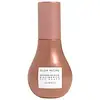Glow Recipe Watermelon Glow Niacinamide Hue Drops Serum Versus Saie Glowy Super Skin Weightless Hydrobounce Serum Foundation
What's inside
What's inside
 Key Ingredients
Key Ingredients

 Benefits
Benefits

 Concerns
Concerns

 Ingredients Side-by-side
Ingredients Side-by-side

Water
Skin ConditioningPropanediol
SolventGlycereth-26
HumectantGlycerin
HumectantNiacinamide
Smoothing2,3-Butanediol
Humectant1,2-Hexanediol
Skin ConditioningCetyl Ethylhexanoate
EmollientCitrullus Lanatus Fruit Extract
Skin ConditioningCentella Asiatica Extract
CleansingSodium Hyaluronate
HumectantMica
Cosmetic ColorantCoffea Arabica Seed Extract
MaskingPolyglyceryl-3 Methylglucose Distearate
EmulsifyingTromethamine
BufferingGlyceryl Stearate Se
EmulsifyingCarbomer
Emulsion StabilisingAcrylates/C10-30 Alkyl Acrylate Crosspolymer
Emulsion StabilisingEthylhexylglycerin
Skin ConditioningXanthan Gum
EmulsifyingPolyquaternium-51
Skin ConditioningButylene Glycol
HumectantTocopherol
AntioxidantParfum
MaskingBenzyl Benzoate
AntimicrobialIron Oxides
CI 77891
Cosmetic ColorantWater, Propanediol, Glycereth-26, Glycerin, Niacinamide, 2,3-Butanediol, 1,2-Hexanediol, Cetyl Ethylhexanoate, Citrullus Lanatus Fruit Extract, Centella Asiatica Extract, Sodium Hyaluronate, Mica, Coffea Arabica Seed Extract, Polyglyceryl-3 Methylglucose Distearate, Tromethamine, Glyceryl Stearate Se, Carbomer, Acrylates/C10-30 Alkyl Acrylate Crosspolymer, Ethylhexylglycerin, Xanthan Gum, Polyquaternium-51, Butylene Glycol, Tocopherol, Parfum, Benzyl Benzoate, Iron Oxides, CI 77891
Althaea Officinalis Root Extract
Skin ConditioningAscorbyl Palmitate
AntioxidantCaprylhydroxamic Acid
Dicaprylyl Carbonate
EmollientDicaprylyl Ether
EmollientGlycerin
HumectantGlyceryl Caprylate
EmollientMagnesium Stearate
Cosmetic ColorantMica
Cosmetic ColorantNeopentyl Glycol Diheptanoate
EmollientOryza Sativa Bran Extract
Skin ConditioningPhyllanthus Emblica Fruit Extract
HumectantPolyester-7
Skin ConditioningPolyglutamic Acid
Skin ConditioningPolyglycerin-6
HumectantPolyglyceryl-6 Polyhydroxystearate
EmulsifyingPolyglyceryl-6 Polyricinoleate
EmulsifyingPotassium Sorbate
PreservativeSodium Benzoate
MaskingSodium Chloride
MaskingSodium Hyaluronate
HumectantSqualane
EmollientStearic Acid
CleansingCI 77891
Cosmetic ColorantTocopherol
AntioxidantTriethoxycaprylylsilane
Trihydroxystearin
Skin ConditioningTrioctyldodecyl Citrate
EmollientWater
Skin ConditioningCI 77491
Cosmetic ColorantCI 77492
Cosmetic ColorantCI 77499
Cosmetic ColorantAlthaea Officinalis Root Extract, Ascorbyl Palmitate, Caprylhydroxamic Acid, Dicaprylyl Carbonate, Dicaprylyl Ether, Glycerin, Glyceryl Caprylate, Magnesium Stearate, Mica, Neopentyl Glycol Diheptanoate, Oryza Sativa Bran Extract, Phyllanthus Emblica Fruit Extract, Polyester-7, Polyglutamic Acid, Polyglycerin-6, Polyglyceryl-6 Polyhydroxystearate, Polyglyceryl-6 Polyricinoleate, Potassium Sorbate, Sodium Benzoate, Sodium Chloride, Sodium Hyaluronate, Squalane, Stearic Acid, CI 77891, Tocopherol, Triethoxycaprylylsilane, Trihydroxystearin, Trioctyldodecyl Citrate, Water, CI 77491, CI 77492, CI 77499
 Reviews
Reviews

Ingredients Explained
These ingredients are found in both products.
Ingredients higher up in an ingredient list are typically present in a larger amount.
Ci 77891 is a white pigment from Titanium dioxide. It is naturally found in minerals such as rutile and ilmenite.
It's main function is to add a white color to cosmetics. It can also be mixed with other colors to create different shades.
Ci 77891 is commonly found in sunscreens due to its ability to block UV rays.
Learn more about CI 77891Glycerin is already naturally found in your skin. It helps moisturize and protect your skin.
A study from 2016 found glycerin to be more effective as a humectant than AHAs and hyaluronic acid.
As a humectant, it helps the skin stay hydrated by pulling moisture to your skin. The low molecular weight of glycerin allows it to pull moisture into the deeper layers of your skin.
Hydrated skin improves your skin barrier; Your skin barrier helps protect against irritants and bacteria.
Glycerin has also been found to have antimicrobial and antiviral properties. Due to these properties, glycerin is often used in wound and burn treatments.
In cosmetics, glycerin is usually derived from plants such as soybean or palm. However, it can also be sourced from animals, such as tallow or animal fat.
This ingredient is organic, colorless, odorless, and non-toxic.
Glycerin is the name for this ingredient in American English. British English uses Glycerol/Glycerine.
Learn more about GlycerinMica is a naturally occurring mineral used to add shimmer and color in cosmetics. It can also help improve the texture of a product or give it an opaque, white/silver color.
Serecite is the name for very fine but ragged grains of mica.
This ingredient is often coated with metal oxides like titanium dioxide. Trace amounts of heavy metals may be found in mica, but these metals are not harmful in our personal products.
Mica has been used since prehistoric times throughout the world. Ancient Egyptian, Indian, Greek, Roman, Aztec, and Chinese civilizations have used mica.
Learn more about MicaSodium Hyaluronate is hyaluronic acid's salt form. It is commonly derived from the sodium salt of hyaluronic acid.
Like hyaluronic acid, it is great at holding water and acts as a humectant. This makes it a great skin hydrating ingredient.
Sodium Hyaluronate is naturally occurring in our bodies and is mostly found in eye fluid and joints.
These are some other common types of Hyaluronic Acid:
Learn more about Sodium HyaluronateTocopherol (also known as Vitamin E) is a common antioxidant used to help protect the skin from free-radicals and strengthen the skin barrier. It's also fat soluble - this means our skin is great at absorbing it.
Vitamin E also helps keep your natural skin lipids healthy. Your lipid skin barrier naturally consists of lipids, ceramides, and fatty acids. Vitamin E offers extra protection for your skin’s lipid barrier, keeping your skin healthy and nourished.
Another benefit is a bit of UV protection. Vitamin E helps reduce the damage caused by UVB rays. (It should not replace your sunscreen). Combining it with Vitamin C can decrease sunburned cells and hyperpigmentation after UV exposure.
You might have noticed Vitamin E + C often paired together. This is because it is great at stabilizing Vitamin C. Using the two together helps increase the effectiveness of both ingredients.
There are often claims that Vitamin E can reduce/prevent scarring, but these claims haven't been confirmed by scientific research.
Learn more about TocopherolWater. It's the most common cosmetic ingredient of all. You'll usually see it at the top of ingredient lists, meaning that it makes up the largest part of the product.
So why is it so popular? Water most often acts as a solvent - this means that it helps dissolve other ingredients into the formulation.
You'll also recognize water as that liquid we all need to stay alive. If you see this, drink a glass of water. Stay hydrated!
Learn more about Water